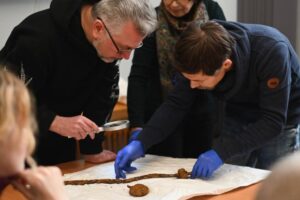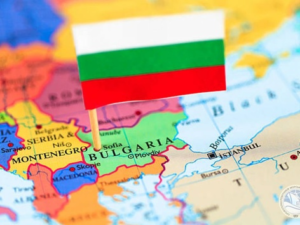
A rare sword from the times of Kievan Rus, accidentally found in the Zhytomyr region, was transferred to the National Museum of Ukrainian History. It is planned to be examined and transferred to the exhibition, the press service of the institution reported.
“On the eve of Christmas, our museum received an unexpected gift – (…) an ancient sword, accidentally found near Radomyshl, and two axes. This exceptional and rare sword dates back to the second half of the 10th – early 11th centuries. The Varangian guards of the Kyiv princes were armed with such swords,” the museum said in a Facebook post on Tuesday.
The artifacts found were donated to the museum by Viktor Moschenko and his daughter Natalia. It is noted that the location is also symbolic. Radomyshl is the territory of the former Drevlyans, where bloody events took place during the times of Oleg, Igor, and Olga.
The Slavic tribe of the Drevlyans lived in the Left Bank Polissya. It was an independent state with a developed economy, princely power, and fortified cities such as Iskorosten (modern Korosten), Vruchy (now Ovruch), Malyn, Mychesk, and Mykhorod (today Radomyshl).

The price of gold on the spot market hit a record high for the 50th time since the beginning of the year due to expectations of a Fed rate cut and demand for safe-haven assets.
During trading on Tuesday, the spot price of gold rose 0.7% to $4,473 per ounce. The day before, gold rose at a record pace for the month, and since the beginning of the year, it has risen 70% and shown the best annual dynamics since 1979.
Other precious metals are also rising in price: the cost of silver increased by 0.2% to $69.2 per ounce, platinum by 1.3%, and palladium by 1%.
Market participants are monitoring events surrounding Venezuela. According to media reports, last weekend the US Coast Guard attempted to intercept another oil tanker allegedly linked to the country’s shadow fleet.
“Geopolitical tensions are back on the agenda,” said Ahmad Assiri of Pepperstone Group. “These events may not have caused an immediate reaction, but they certainly increase the demand for gold as a hedge against risk.”
In addition, investors believe that the Fed will continue to lower its key rate amid a weakening labor market. Low interest rates are a positive factor for gold prices, as they increase the relative attractiveness of investments in precious metals, which do not generate interest income.
Goldman Sachs analysts predict that in 2026, gold will rise to $4,900 per ounce in the base scenario.

The property of Novokakhovsky processed cheese factory LLC (Kherson region), which is in the process of bankruptcy, has been put up for auction with a starting price of UAH 4.91 million, according to the Ukrainian Universal Exchange.
According to the information provided by the resource, one lot has been put up for auction, which includes 17 items of movable property: food industry equipment, in particular, packaging machines of various years of manufacture, a separator, clip machines, a vacuum packaging machine, installations for melting food raw materials and cheese, as well as motor vehicles – three Jungheinrich and Goodsense forklifts.
The auction will be conducted according to the English model (with a gradual increase in bids – IF-U) with a step of 1% of the starting price. To participate, a 10% security deposit must be paid.
The customer of the auction is the arbitration manager and liquidator of the enterprise, acting on the basis of the decision of the Economic Court of the Kherson Region dated December 9, 2021. At the same time, the debtor’s property is pledged to ProCredit Bank JSC.
The plant’s property is located in a war zone. The liquidator has warned that he cannot guarantee the safe inspection or preservation of the equipment until it is transferred to the buyer.
Applications to participate in the auction will be accepted until January 6. The auction is scheduled for January 7, 2026.

According to the Serbian Economist, Bulgaria has started accepting applications for a long-term stay permit on the basis of “digital nomad” – the relevant changes to the by-laws came into force on December 20, 2025.
As Bulgarian Telegraphic Agency reported, the introduction of the procedure for issuing such a permit is intended to create a clear procedure for foreigners who want to live in the country and work remotely without a relationship with a local employer, as well as to bring economic benefits by attracting specialists in innovation, high technology and creative industries.
Upon initial application or renewal of the permit, the applicant must, inter alia, prove an average annual income of at least 50 minimum monthly salaries for the previous calendar year and provide documents proving remote employment – an employment contract with the employer or contract(s) for remote services and recommendations from the customer(s), and the work or services must not be provided to persons and companies in Bulgaria.
Bulgarian legislation defines three categories of “digital nomads”: employees of an employer outside the EU/EEA/Switzerland; owners/shareholders (with a share of more than 25%) or management of companies registered outside the EU/EEA/Switzerland; and persons who have provided remote services for at least one year prior to the application, provided there is no employment on the Bulgarian market. The permit is valid for one year, renewable for another year; the procedure usually involves obtaining a D visa and subsequent regularization in Bulgaria.
https://t.me/relocationrs/1988

Sales of new buses in Ukraine in 2025 will grow by 13-15% compared to 2024 – to 940-950 units, according to Vadym Shkarupin, director of the Etalon Auto trading house.
“Although the year is not over yet, and we, like other companies, are still working, according to open data (excluding closed purchases), about 940-950 buses will be sold, compared to 831 buses last year,” he said at a press conference in Kyiv on Monday.
According to his data, Ataman buses manufactured by the Cherkasy Bus plant are in first place in sales this year with 370 units (market share of 39%), followed by ZAZ buses from the Zaporizhzhia Automobile Plant (UKRAVTO Group) with 240 units (24%), and third place goes to Etalon buses manufactured by the Chernihiv Automobile Plant, with 130 units (14%).
Next in the ranking are Bogdan buses (manufactured by BAS Motor in Lutsk) with 100 units (11%), and fifth place is taken by imported Isuzu buses (50 units or 6% of the market).
Another 50 buses are from other manufacturers: Turkish Temsa, Otocar, and two Elektron buses.
The largest number of buses sold were in the small class – 720 units (77%), 160 units (17%) were sold in the medium class, and 60 units (6.5%) in the large class.
Almost all buses sold were diesel-powered, with two electric buses sold.
“In terms of structure, 88-90% of sales were made using budget funds: for example, of the 940 buses sold, 720 were school buses. No more than 12% were sold to retailers, but this cannot even be called retail, because these were purchases made by companies for their own needs, to transport personnel. We had orders from Ukrnafta, from the Khmelnytskyi Nuclear Power Plant, and other manufacturers are also working in this direction. Meanwhile, retail is at a standstill today, there are no purchases,” Shkarupin said.
At the same time, he noted that Ukrainian companies have work thanks to the School Bus program.